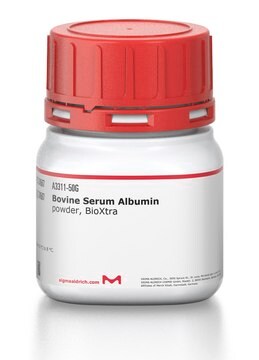A6003
Bovine Serum Albumin
lyophilized powder, essentially fatty acid free, ≥96% (agarose gel electrophoresis)
Synonym(s):
Albumin bovine serum, BSA, Bovine albumin
About This Item
Recommended Products
biological source
bovine
assay
≥96% (agarose gel electrophoresis)
≥96%
form
lyophilized powder
mol wt
~66 kDa
purified by
cold ethanol fractionation
packaging
poly bottle of
origin
USA origin
free fatty acid content
≤0.01%
technique(s)
microbiological culture: suitable
impurities
≤0.01% fatty acid (GC)
pH
7
solubility
water: soluble (50 mg/ml)
UniProt accession no.
application(s)
hematology
foreign activity
BT virus, none detected
VSV virus, none detected
storage temp.
2-8°C
Gene Information
bovine ... ALB(280717)
Looking for similar products? Visit Product Comparison Guide
General description
This BSA product is specifically tested for very low FA content / fatty acid free status.
Biochem/physiol Actions
Features and Benefits
- Cold ethanol fractionated
- Essentially fatty acid-free
Preparation Note
Storage Class
11 - Combustible Solids
wgk_germany
WGK 3
flash_point_f
Not applicable
flash_point_c
Not applicable
ppe
Eyeshields, Gloves, type N95 (US)
Certificates of Analysis (COA)
Search for Certificates of Analysis (COA) by entering the products Lot/Batch Number. Lot and Batch Numbers can be found on a product’s label following the words ‘Lot’ or ‘Batch’.
Already Own This Product?
Find documentation for the products that you have recently purchased in the Document Library.
Customers Also Viewed
Protocols
Enzymatic Assay of 3α-Hydroxysteroid Dehydrogenase with Androsterone (EC 1.1.1.50)
Enzymatic Assay of Neuraminidase applies to products that have a specification for neuraminidase content by enzymatic determination.
Our team of scientists has experience in all areas of research including Life Science, Material Science, Chemical Synthesis, Chromatography, Analytical and many others.
Contact Technical Service





